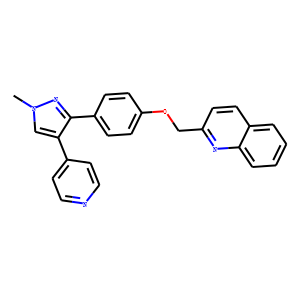| Reference | 1. Front Mol Neurosci. 2017 Apr 7;10:100. doi: 10.3389/fnmol.2017.00100. eCollection 2017.<br />
The Phosphodiesterase 10A Inhibitor PF-2545920 Enhances Hippocampal Excitability and Seizure Activity Involving the Upregulation of GluA1 and NR2A in Post-synaptic Densities.<br />
Zhang Y(1), Gao B(2), Zheng F(1), Lu S(1), Li Y(1), Xiong Y(1), Yang Q(1), Yang Y(1), Fu P(1), Xiao F(1), Wang X(1)(3)(4).<br />
Author information:<br />
(1)Department of Neurology, The First Affiliated Hospital of Chongqing Medical UniversityChongqing, China. (2)Department of Neurology, Chongqing General HospitalChongqing, China. (3)Center of Epilepsy, Beijing Institute for Brain DisordersBeijing, China. (4)Chongqing Key Laboratory of NeurologyChongqing, China.<br />
Phosphodiesterase regulates the homeostasis of cAMP and cGMP, which increase the strength of excitatory neural circuits and/or decrease inhibitory synaptic plasticity. Abnormally, synchronized synaptic transmission in the brain leads to seizures. A phosphodiesterase 10A (PDE10A) inhibitor PF-2545920 has recently attracted attention as a potential therapy for neurological and psychiatric disorders. We hypothesized that PF-2545920 plays an important role in status epilepticus (SE) and investigated the underlying mechanisms. PDE10A was primarily located in neurons, and PDE10A expression increased significantly in patients with temporal lobe epilepsy. PF-2545920 enhanced the hyperexcitability of pyramidal neurons in rat CA1, as measured by the frequency of action potentials and miniature excitatory post-synaptic current. GluA1 and NR2A expression also increased significantly in post-synaptic densities, with or without SE in rats treated with PF-2545920. The ratio of p-GluA1/GluA1 increased in the presence of PF-2545920 in groups with SE. Our results suggest that PF-2545920 facilitates seizure activity via the intracellular redistribution of GluA1 and NR2A in the hippocampus. The upregulation of p-GluA1 may play an important role in trafficking GluA1 to post-synaptic densities. The data suggest it would be detrimental to use the drug in seizure patients and might cause neuronal hyperexcitability in non-epileptic individuals.<br />
2. Neuropharmacology. 2015 Dec;99:379-86. doi: 10.1016/j.neuropharm.2015.08.008. Epub 2015 Aug 7.<br />
Phosphodiesterase 10A inhibitor, MP-10 (PF-2545920), produces greater induction of c-Fos in dopamine D2 neurons than in D1 neurons in the neostriatum.<br />
Wilson JM(1), Ogden AM(2), Loomis S(3), Gilmour G(3), Baucum AJ 2nd(4), Belecky-Adams TL(5), Merchant KM(5).<br />
Author information:<br />
(1)Lilly Research Laboratories, Eli Lilly and Company, Indianapolis, IN, 46225, USA; Department of Biology, Center for Developmental and Regenerative Biology, Indiana University-Purdue University, Indianapolis 723 West Michigan Street, Indianapolis, IN, 46202, USA. Electronic address: [email protected]. (2)Lilly Research Laboratories, Eli Lilly and Company, Indianapolis, IN, 46225, USA. (3)Eli Lilly and Company Ltd., Erl Wood Manor, Sunninghill Road, Windlesham, Surrey GU20 6PH, UK. (4)Department of Biology, Center for Developmental and Regenerative Biology, Indiana University-Purdue University, Indianapolis 723 West Michigan Street, Indianapolis, IN, 46202, USA; Stark Neurosciences Research Institute, Indiana University-Purdue University, Indianapolis 723 West Michigan Street, Indianapolis, IN, 46202, USA. (5)Department of Biology, Center for Developmental and Regenerative Biology, Indiana University-Purdue University, Indianapolis 723 West Michigan Street, Indianapolis, IN, 46202, USA.<br />
Studies described here tested the hypothesis that phosphodiesterase 10A inhibition by a selective antagonist, MP-10, activates the dopamine D2 receptor expressing medium spiny neurons to a greater extent than the D1 receptor expressing neurons. We used regional pattern of c-Fos induction in the neostriatal subregions of rodents and direct assessment of D1-positive and -negative neurons in the DRd1a-tdTomato mice for the purpose. MP-10 (1, 3, 10 or 30 mg/kg, PO) dose-dependently increased c-Fos immunopositive nuclei in all regions of neostriatum. However, the effect was statistically greater in the dorsolateral striatum, a region known to be activated preferentially by the D2 antagonism, than the D1-activated dorsomedial striatum. The D2 antagonist, haloperidol (0.3, 1, or 3 mg/kg, PO) produced an identical, regional pattern of c-Fos induction favoring the dorsolateral striatum of the rat. In contrast, the D1 agonist, SKF82958 (0.5, 1, or 2 mg/kg, PO), induced greater expression of c-Fos in the dorsomedial striatum. The C57Bl/6 mouse also showed regionally preferential c-Fos activation by haloperidol (2 mg/kg, IP) and SKF82858 (3 mg/kg, IP). In the Drd1a-tdTomato mice, MP-10 (3 or 10 mg/kg, IP) increased c-Fos immunoreactivity in both types of neurons, the induction was greater in the D1-negative neurons. Taken together, both the regional pattern of c-Fos induction in the striatal sub-regions and the greater induction of c-Fos in the D1-negative neurons indicate that PDE10A inhibition produces a small but significantly greater activation of the D2-containing striatopallidal pathway.<br />
3. J Med Chem. 2009 Aug 27;52(16):5188-96. doi: 10.1021/jm900521k.<br />
Discovery of a novel class of phosphodiesterase 10A inhibitors and identification of clinical candidate 2-[4-(1-methyl-4-pyridin-4-yl-1H-pyrazol-3-yl)-phenoxymethyl]-quinoline (PF-2545920) for the treatment of schizophrenia.<br />
Verhoest PR(1), Chapin DS, Corman M, Fonseca K, Harms JF, Hou X, Marr ES, Menniti FS, Nelson F, O/'Connor R, Pandit J, Proulx-Lafrance C, Schmidt AW, Schmidt CJ, Suiciak JA, Liras S.<br />
Author information:<br />
(1)Neuroscience, Pfizer Global Research and Development, Eastern Point Road, Groton, CT 06340, USA. [email protected]<br />
By utilizing structure-based drug design (SBDD) knowledge, a novel class of phosphodiesterase (PDE) 10A inhibitors was identified. The structure-based drug design efforts identified a unique /selectivity pocket/ for PDE10A inhibitors, and interactions within this pocket allowed the design of highly selective and potent PDE10A inhibitors. Further optimization of brain penetration and drug-like properties led to the discovery of 2-[4-(1-methyl-4-pyridin-4-yl-1H-pyrazol-3-yl)-phenoxymethyl]-quinoline (PF-2545920). This PDE10A inhibitor is the first reported clinical entry for this mechanism in the treatment of schizophrenia.<br />
|

